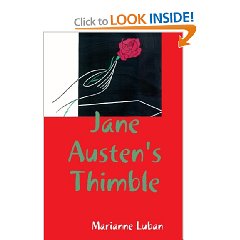 The scene at left is from the tomb of Amenhotep [also called Huy] and depicts Nubians bringing tribute to Tutankhamun. This section of the longer scene shows a lady accompanied by some men and the caption next to them reads " children of the chiefs of all countries" [of the southern regions]. These are, unlike the other foreigners in the painting, dressed in Egyptian-style costume and jewelry. Note, however, that a new style seems to be involved as the people from the south have straps on the heels of their white sandals and beads descend from their upper armlets. The lady appears to be wearing a golden diadem, which perhaps has golden elements hanging from it that cover her hair. Either that, or she is wearing a blonde wig or has had her own hair bleached by some method. Perhaps this woman and her companions are part of the tribute, a suit for peace that includes much gold and the children of some chieftain--especially the young woman, as females were not emissaries, normally. It would not be far fetched to conclude that the lady is intended as a wife of the pharaoh, Tutankhamun, and there is no other conceivable reason for her presence.
The scene at left is from the tomb of Amenhotep [also called Huy] and depicts Nubians bringing tribute to Tutankhamun. This section of the longer scene shows a lady accompanied by some men and the caption next to them reads " children of the chiefs of all countries" [of the southern regions]. These are, unlike the other foreigners in the painting, dressed in Egyptian-style costume and jewelry. Note, however, that a new style seems to be involved as the people from the south have straps on the heels of their white sandals and beads descend from their upper armlets. The lady appears to be wearing a golden diadem, which perhaps has golden elements hanging from it that cover her hair. Either that, or she is wearing a blonde wig or has had her own hair bleached by some method. Perhaps this woman and her companions are part of the tribute, a suit for peace that includes much gold and the children of some chieftain--especially the young woman, as females were not emissaries, normally. It would not be far fetched to conclude that the lady is intended as a wife of the pharaoh, Tutankhamun, and there is no other conceivable reason for her presence.The status of the female is further indicated by the fact that she stands alone, here and in her ox-drawn chariot farther back in the scene, while her compatriots are shown in groups.
Tutankhamun, as we know, already had a wife named Ankhesenamun, his close relative, but the kings of Egypt were not monogamous as a rule. If this Kushite girl was given to Tut in a political marriage, she would have been secondary to the Great Wife, Ankhesenamun, however. That we do not see this girl depicted with Tutankhamun in a wifely role would not have been unusual, either. In the 18th Dynasty, lesser wives were not depicted with their royal husbands.








3 comments:
Hi Marianne
I would expect a harem for each King regardless of his need for it,gifts of foreign beauties or Princess' to the Egyptian King may have been fairly common though it has not been shown to my knowledge what part of the Kings reproductive abilities may have been his duty to his office?
cheers
tim
I actually saw a portion of that tomb painting (photo re-creation of course) when the exhibit, "Nubian Pharaohs" came to Atlanta a couple of years ago. The panel did not include the young woman but she certainly looks as if she is being offered up as a gift. Too bad there is not more information on her or on Tut's lesser wives or concubines...
Hi Vicky and Tim,
I would add to that it's too bad we don't have more information about Tut, himself! Even his "Restoration Stela" was usurped by Horemheb and, unfortunately, hardly any of his officials are buried in the Valley as Tutankhamun probably reigned mainly from Memphis. Yet, since his tomb was discovered in the early 20's, every few decades we seem to learn a little more about the young king. A French team excavated the tomb of his nurse, Maya, at Saqqara and there we have little Tut sitting on this woman's lap. Quite a surprise for the excavators. Now the DNA testing...so perhaps--who knows--in time we may come to know more. My guess is that Tut also had a regent for the first few years of his reign, probably a woman, as was customary. Perhaps we will find out someday who it was.
Post a Comment